10+ Project Quality Management Plan Examples to Download
The main cause of having a successful project is through the help of a project qualitymanagement plan. This type of plan is to be carried out by project managers who have a deep understanding of the subject matter and who can execute properly the phases in a project management plan. There are a lot of professionals who think that a project management plan is just the same as a Gantt chart. In this article, you will be able to know about the definition of a project management plan, its components and how to create one.
10+ Project Quality Management Plan Examples
1. Project Quality Management Plan Template
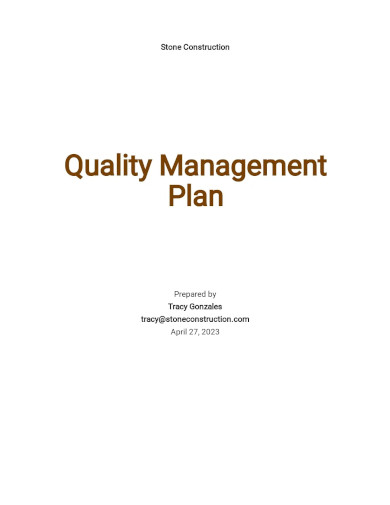
2. Simple Project Quality Management Plan Template
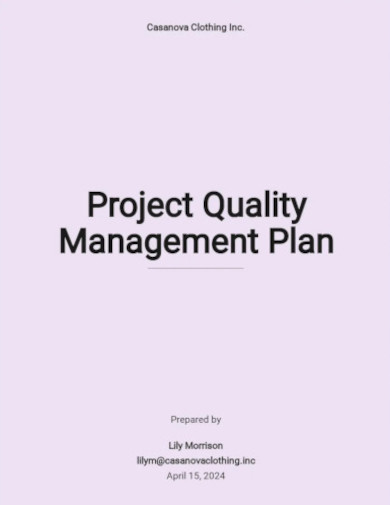
3. Project Management Quality Control Plan Template
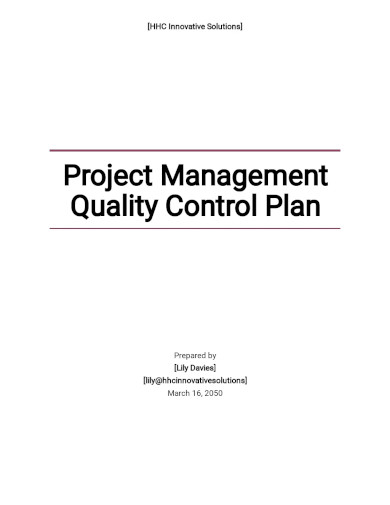
4. Natural Gas Project Quality Management Plan
5. Standard Project Quality Management Plan
6. Catalyst Project Quality Management Plan
7. Printable Project Quality Management Plan
8. Project Quality Management Plan in PDF
9. Basic Project Quality Management Plan
10. Environmental Project Quality Management Plan
11. Building Project Quality Management Plan
Project Management Plan Definition
A project management plan is a type of document that gives a definition of how a certain project is executed, controlled and monitored. It may appear in a form of a summary that includes baselines, subsidiary management plans and other documents that involves planning. This shows the kind of approach that a team should deliver intended for the benefit of the project scope.
The project performance will be measured through a performance measurement baseline. This refers to the scope baseline, cost baseline and schedule baseline. Project managers ensure that they will be able to spend time trying to check if the baselines have already been achieved or if the organization itself got the benefits of their respective projects. Aside from taking over in the planning process, the project manager should also control the project and ensure the project deliverables.
Components of a Project Management Plan
Since we have highlighted that a project management plan is a collection of baselines and sets of plans, it should include the following components:
- Baselines that are incorporated with scope, schedule and cost
- Management plans for the scope, schedule and cost and also to the risk and procurement, communication and quality and human resources.
- Change management plan
- Configuration management plan
- Requirement management plan
- Process management plan
Phases of Project Management
There are five (5) phases of project management:
Phase 1: Project Initiation
The ultimate goal of this phase is just to describe the project in a broad sense. This will usually begin in business cases where you are going to research to check if the project is feasible or not. If there is a need for a feasibility to be done, this is the right phase in which it will be completed.
Phase 2: Project Planning
This phase would usually begin by setting goals. One of the best method to use is the SMART goal setting. SMART stands for Specific, Measurable, Attainable, Realistic and Timely.
Specific – this answers the questions starting from what, when, where, who, why, and which.
Measurable – it should be in lined with a criteria that enables you to measure the success towards your goal.
Attainable – you should be able to identify the important goals and how you would be able to achieve them.
Realistic – make sure that you should be able to work towards your goal.
Timely – secure a timeframe that helps you achieve your goal.
Phase 3: Project Execution
This is where you are going to find out that your deliverables are already developed and completed.
Phase 4: Project Performance
This will help you measure the progress and performance to make sure that everything is aligned to your project management plan.
Phase 5: Project Closure
This is the phase that you know you have completed the project.
FAQs
What are some of the tasks to be completed in the execution phase?
Some of the tasks would include develop team, assign resources, set up tracking systems, update project schedules, execute project management plans and more.
Aside from SMART goal setting, what else can you use in project planning?
You may also use the CLEAR goals. CLEAR stands for Collaborative, Limited, Emotional, Appreciable and Refined.
What are the key performance indicator in measuring for project performance?
KPIs include project objectives, quality deliverables, effort and cost tracking, and project performance.
A project management plan is probably one of the most essential in terms of having deliverables. It holds information that will use in order to determine whether the project you have been planning is moving forward or otherwise. That is why having an effective project management plan is a good idea to start in the construction of your project.
10+ Project Quality Management Plan Examples to Download
![10+ Project Quality Management Plan Examples [ Research, University, Environmental ]](https://images.examples.com/wp-content/uploads/2021/06/10-Project-Quality-Management-Plan-Examples-Research-University-Environmental-.jpg)
The main cause of having a successful project is through the help of a project qualitymanagement plan. This type of plan is to be carried out by project managers who have a deep understanding of the subject matter and who can execute properly the phases in a project management plan. There are a lot of professionals who think that a project management plan is just the same as a Gantt chart. In this article, you will be able to know about the definition of a project management plan, its components and how to create one.
10+ Project Quality Management Plan Examples
1. Project Quality Management Plan Template

Details
File Format
MS Word
Google Docs
Pages
PDF
2. Simple Project Quality Management Plan Template

Details
3. Project Management Quality Control Plan Template

Details
4. Natural Gas Project Quality Management Plan
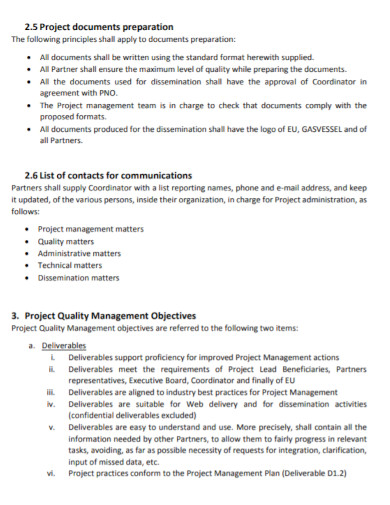
gasvessel.eu
Details
File Format
PDF
Size: 834 KB
5. Standard Project Quality Management Plan
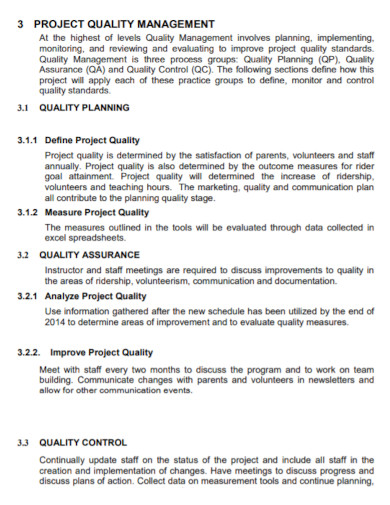
tead.on.ca
Details
File Format
PDF
Size: 142 KB
6. Catalyst Project Quality Management Plan
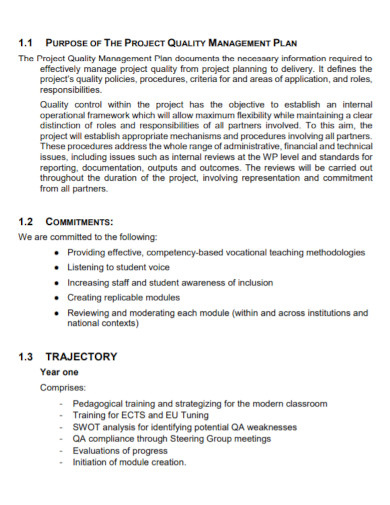
catalyst-erasmus.com
Details
File Format
PDF
Size: 410 KB
7. Printable Project Quality Management Plan

saspublishers.com
Details
File Format
PDF
Size: 248 KB
8. Project Quality Management Plan in PDF
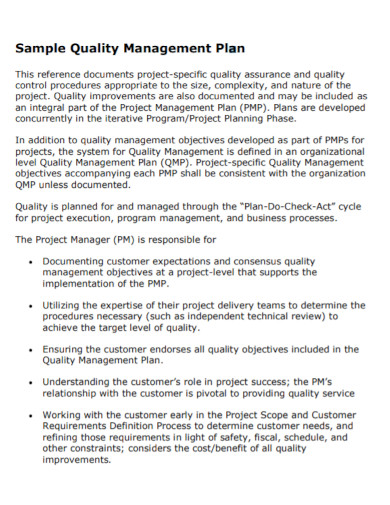
acqnotes.com
Details
File Format
PDF
Size: 83 KB
9. Basic Project Quality Management Plan
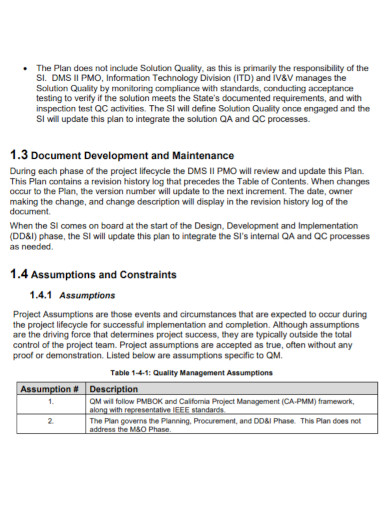
capmf.cdt.ca.gov
Details
File Format
PDF
Size: 2 MB
10. Environmental Project Quality Management Plan

denvergov.org
Details
File Format
PDF
Size: 502 KB
11. Building Project Quality Management Plan
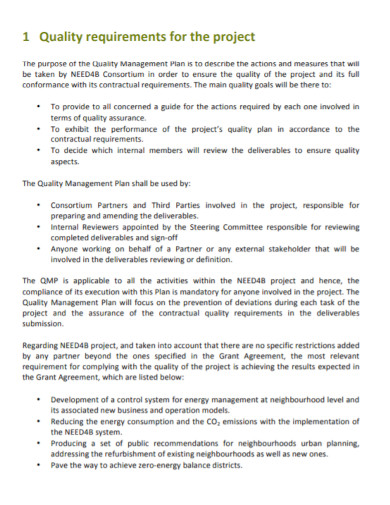
needb.eu
Details
File Format
PDF
Size: 776 KB
Project Management Plan Definition
A project management plan is a type of document that gives a definition of how a certain project is executed, controlled and monitored. It may appear in a form of a summary that includes baselines, subsidiary management plans and other documents that involves planning. This shows the kind of approach that a team should deliver intended for the benefit of the project scope.
The project performance will be measured through a performance measurement baseline. This refers to the scope baseline, cost baseline and schedule baseline. Project managers ensure that they will be able to spend time trying to check if the baselines have already been achieved or if the organization itself got the benefits of their respective projects. Aside from taking over in the planning process, the project manager should also control the project and ensure the project deliverables.
Components of a Project Management Plan
Since we have highlighted that a project management plan is a collection of baselines and sets of plans, it should include the following components:
Baselines that are incorporated with scope, schedule and cost
Management plans for the scope, schedule and cost and also to the risk and procurement, communication and quality and human resources.
Configuration management plan
Requirement management plan
Process management plan
Phases of Project Management
There are five (5) phases of project management:
Phase 1: Project Initiation
The ultimate goal of this phase is just to describe the project in a broad sense. This will usually begin in business cases where you are going to research to check if the project is feasible or not. If there is a need for a feasibility to be done, this is the right phase in which it will be completed.
Phase 2: Project Planning
This phase would usually begin by setting goals. One of the best method to use is the SMART goal setting. SMART stands for Specific, Measurable, Attainable, Realistic and Timely.
Specific – this answers the questions starting from what, when, where, who, why, and which.
Measurable – it should be in lined with a criteria that enables you to measure the success towards your goal.
Attainable – you should be able to identify the important goals and how you would be able to achieve them.
Realistic – make sure that you should be able to work towards your goal.
Timely – secure a timeframe that helps you achieve your goal.
Phase 3: Project Execution
This is where you are going to find out that your deliverables are already developed and completed.
Phase 4: Project Performance
This will help you measure the progress and performance to make sure that everything is aligned to your project management plan.
Phase 5: Project Closure
This is the phase that you know you have completed the project.
FAQs
What are some of the tasks to be completed in the execution phase?
Some of the tasks would include develop team, assign resources, set up tracking systems, update project schedules, execute project management plans and more.
Aside from SMART goal setting, what else can you use in project planning?
You may also use the CLEAR goals. CLEAR stands for Collaborative, Limited, Emotional, Appreciable and Refined.
What are the key performance indicator in measuring for project performance?
KPIs include project objectives, quality deliverables, effort and cost tracking, and project performance.
A project management plan is probably one of the most essential in terms of having deliverables. It holds information that will use in order to determine whether the project you have been planning is moving forward or otherwise. That is why having an effective project management plan is a good idea to start in the construction of your project.

